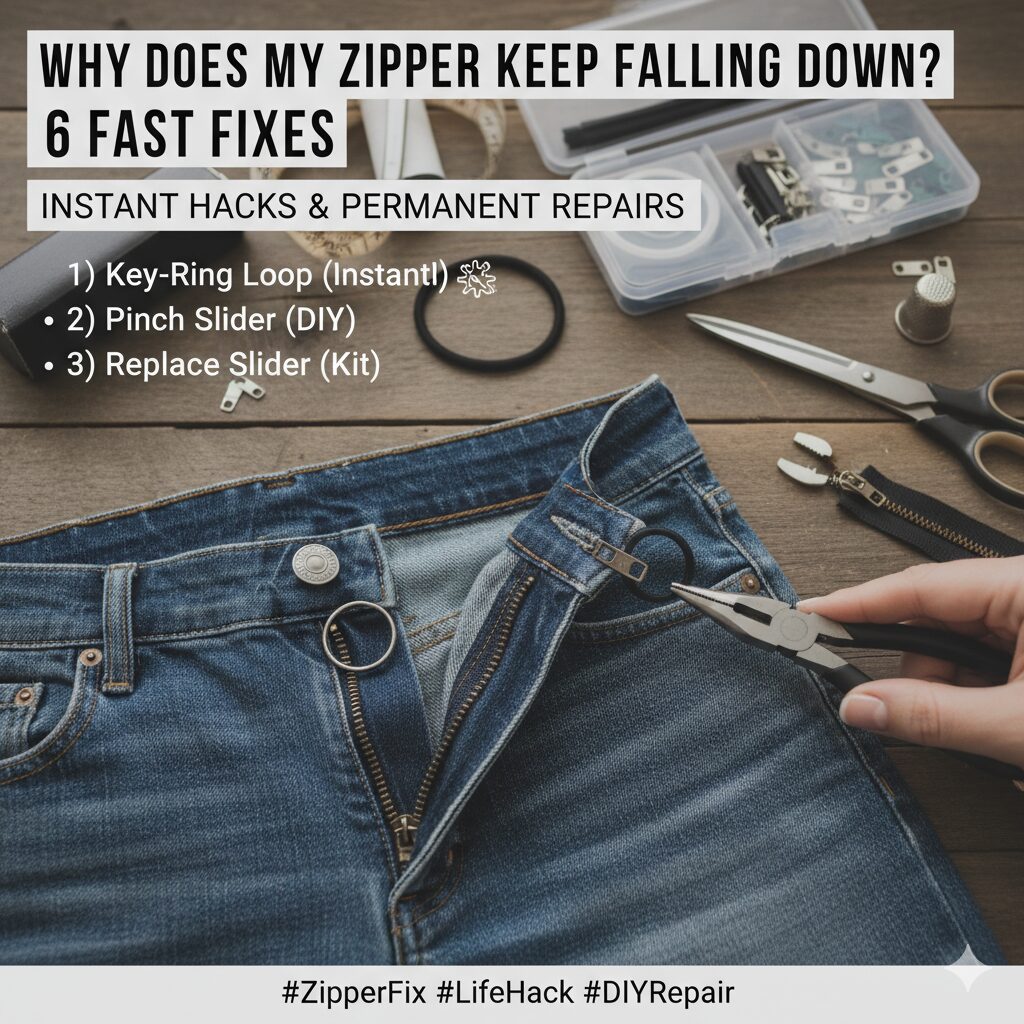
Why Does My Zipper Keep Falling Down? — The Real Reason + 6 Fast Fixes
Zippers fall down because of worn or loose sliders, missing or damaged stops, or damaged teeth/coils. Temporary fixes like looping a key ring work instantly; long-term solutions include tightening or replacing the slider, or replacing the zipper. Typical repair costs range from free (DIY) up to about $75–$135 for complex jobs on heavy garments.
Short history: Why zippers open down on pants
The modern zipper was engineered in the early 20th century and adopted into clothing to replace buttons and clasps. Tailoring convention already used an overlapping flap called a fly that opened downward for modesty and convenience. When zippers replaced buttons, designers preserved the same direction of opening — so pants zippers typically unzip downward by design.
The three mechanical reasons your zipper falls
- Worn or loose slider: Over time the slider’s internal grip can loosen and no longer pull teeth together tightly.
- Missing or damaged top/bottom stops: Stops prevent the slider from slipping past a point; if they’re broken, the slider can slide down.
- Damaged or misaligned teeth/coil: Bent or missing teeth (or separated coil stitching) prevent proper locking even when the slider is fine.
6 fixes — from instant hacks to permanent repairs
-
1) Key-ring loop (instant, free)
Thread a small key ring through the zipper pull and hook it over the pants button before buttoning. Works immediately and is invisible from a distance. -
2) Rubber band / hair tie loop (instant, ~20s)
Use a small rubber band or hair tie in the same way as the key ring. Quick and discreet. -
3) Pinch the slider to tighten (quick DIY, 5 minutes)
Using needle-nose pliers, gently pinch the back of a metal or robust plastic slider to reduce internal play. Test after each small squeeze. (Do not over-pinching brittle plastic sliders.) -
4) Replace the slider (DIY permanent, 15–30 minutes)
Buy a universal slider kit sized to your zipper, remove the old slider, fit the new one, and crimp new stops. Cost: $7–$25 for kit and parts. -
5) Full zipper replacement (tailor or DIY, 30–90+ minutes)
If teeth or tape are damaged, replacing the whole zipper is usually the most durable option. Typical cost for pants: $10–$40; for heavy jackets or technical gear: $75–$135. -
6) Professional repair kit or mail-in service
Specialty kits and mail-in repair shops can supply the correct parts and instructions. Good when you want a durable result without visiting a tailor. Typical kit prices: $13–$40.
Quick decision guide
Use this order to decide what to try:
- If the zipper falls occasionally but teeth look fine — try the key-ring or pinch the slider trick first.
- If the slider is visibly worn or chewed — buy a slider replacement kit.
- If teeth or tape are damaged or missing — consider a full zipper replacement.
- If the garment is valuable (leather, designer) — take it to a specialist or trusted tailor.
Zipper types and how they affect repairs
Different zipper constructions respond differently to fixes:
- Coil (nylon): Flexible and smooth; harder to pinch-fix but often repairable with a new slider.
- Metal: Easier to tighten and often responds well to slider pinching.
- Molded plastic: Lightweight but can be brittle; avoid over-tightening sliders on these.
FAQ
- Will pinching the slider ruin the zipper?
- When done gently, pinching should not ruin a metal or robust plastic slider. Avoid over-crimping brittle or thin plastic sliders. Test incrementally.
- How much does a tailor charge to replace a pants zipper?
- Typical price ranges: $10–$40 for most pants; heavy jackets or technical garments can cost $75–$135.
- When should I replace the whole zipper?
- Replace the whole zipper if multiple teeth are damaged or the fabric tape is torn, or if repeated slider fixes fail to hold.

Leave a Reply